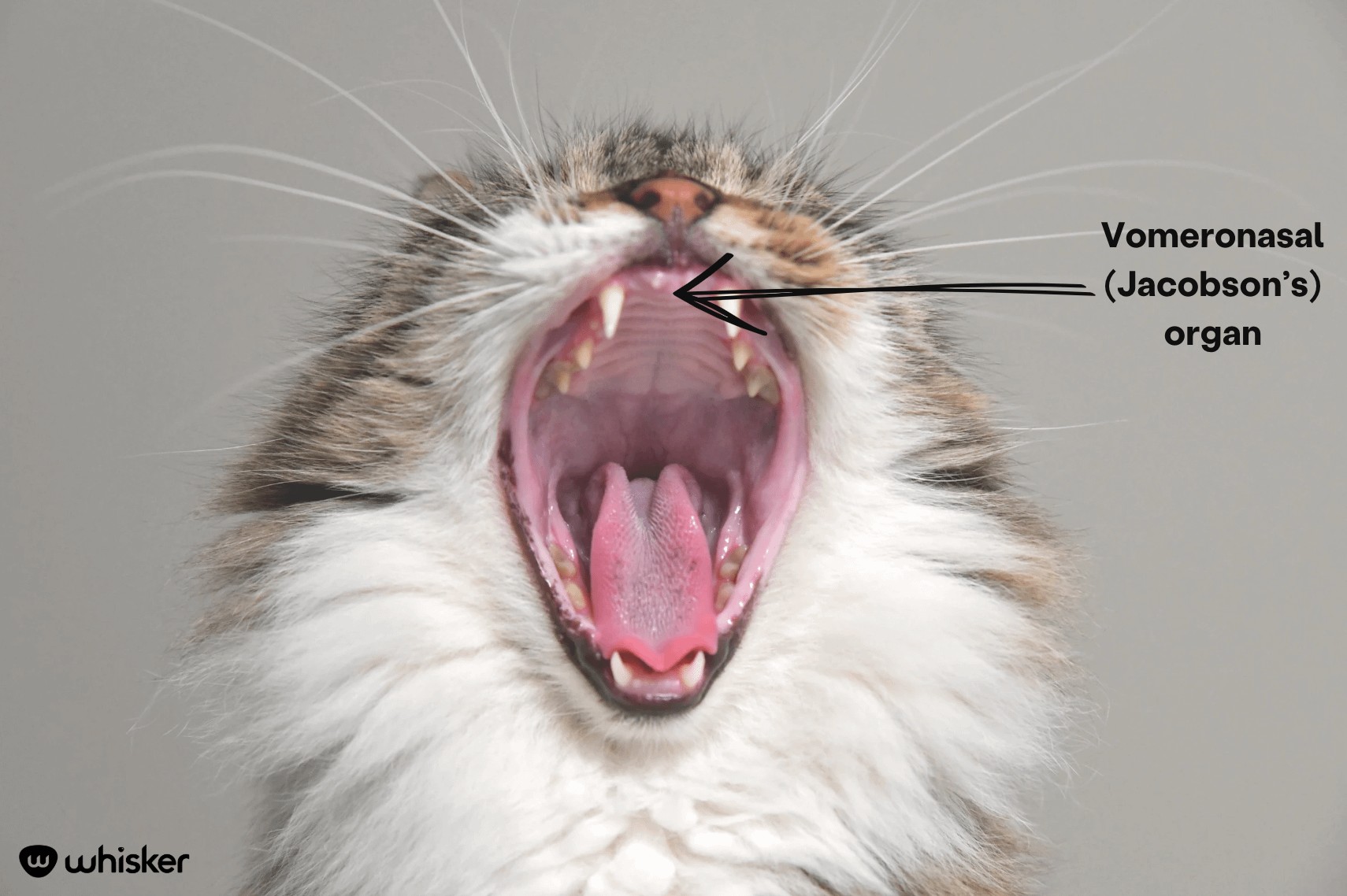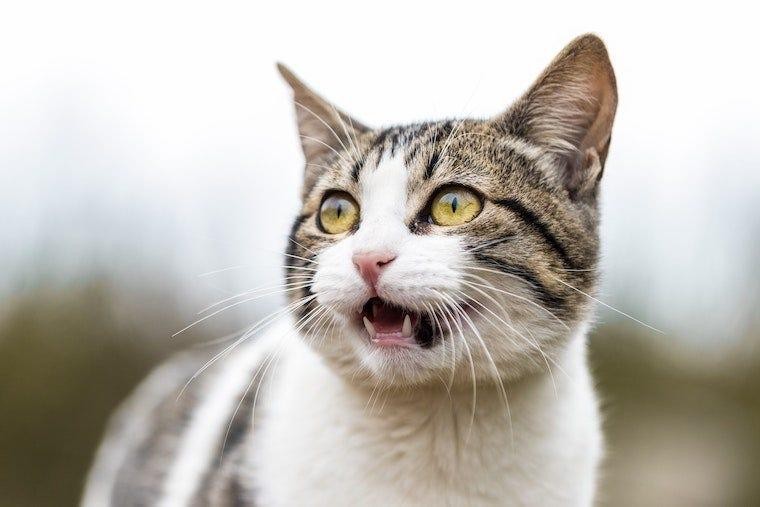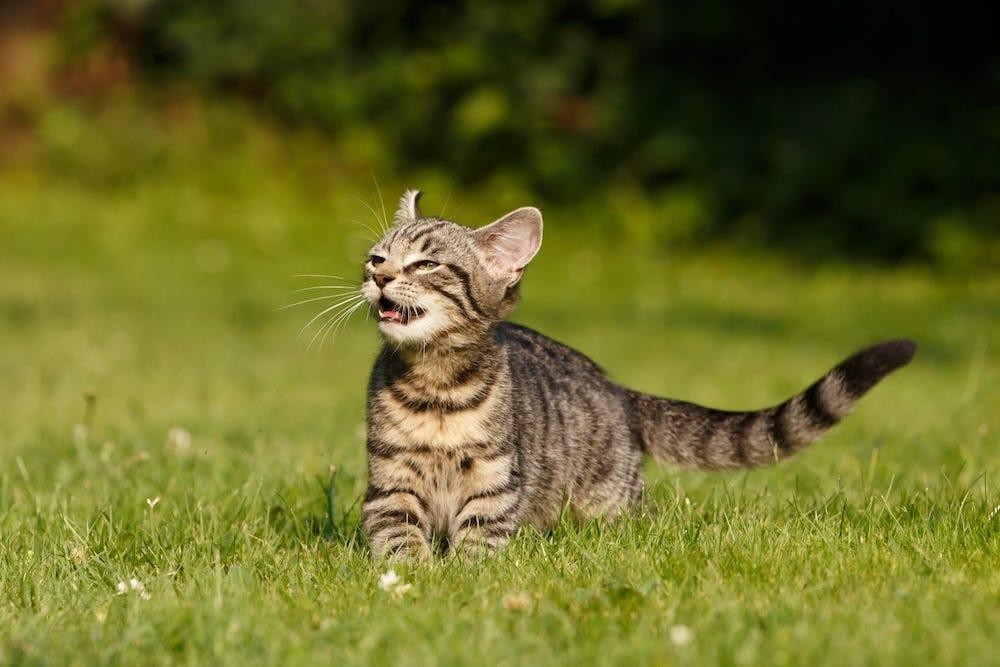Cats exhibit peculiar behaviors, and if you’ve observed your feline friend opening their mouth slightly after sniffing something, you’re not alone. This action, known as the flehmen response, is a fascinating way cats analyze scents, and at WHY.EDU.VN, we are dedicated to providing you with a comprehensive understanding of such animal behaviors. This article will dissect the flehmen response, exploring why it happens and what it means, offering insights into your cat’s sensory world. Delve deeper into feline communication and olfactory investigation to understand your cat’s gape expression and scent detection capabilities.
1. What is the Flehmen Response in Cats?
The flehmen response in cats, also known as the “cat stinky face” or “gape,” is a behavior where a cat opens its mouth slightly, curls back its upper lip, and wrinkles its nose after smelling something intriguing. Instead of analyzing smells through their nostrils, they engage in “scent-sucking” through the roof of their mouth. This peculiar expression is a voluntary action that allows cats to detect and analyze pheromones and other scents more effectively, a sense somewhere between smell and taste.
2. How Does the Flehmen Response Work?
The flehmen response opens two small ducts on the roof of your cat’s mouth, behind the incisors. These ducts allow the scent to travel to the vomeronasal organ (VNO), also called Jacobson’s organ, inside the nasal cavity. By taking in smells via this method, cats can detect chemicals by using nerves that lead directly to the brain—even odorless or undetectable smells.
3. Why Do Cats Use the Flehmen Response?
Cats use the flehmen response primarily to enhance their ability to detect and interpret pheromones. Pheromones are chemical signals that cats and other animals use to communicate information about identity, reproductive status, and territory. The flehmen response allows cats to draw these pheromones into their vomeronasal organ (VNO), where they can be analyzed more thoroughly.
4. What Triggers the Flehmen Response in Cats?
The flehmen response in cats is typically triggered by strong or unfamiliar scents. Common triggers include:
- Urine markings: Especially from other cats, as they use pheromones to communicate.
- Female cat pheromones: Males commonly use it when detecting the pheromones of a female in heat.
- Mother cats tracking their kittens: They use it to identify and monitor their young through scent.
- New or strong-smelling objects: Such as certain foods, plants, or even human sweat. Catnip is especially famous for triggering the flehmen response in cats as it produces a chemical response in a cat’s brain when inhaled or ingested.
- Household smells: If something carries a particularly intriguing or unfamiliar scent.
5. What Does the Flehmen Response Look Like?
When a cat exhibits the flehmen response, it may appear to be:
- Slightly opening its mouth while pausing mid-sniff.
- Curling back its upper lip, exposing some teeth.
- Squinting or widening its eyes as it focuses on the scent.
- Holding the pose for a few seconds, almost as if in deep thought.
6. Where Do Cats Most Often Exhibit the Flehmen Response?
Cats will most often exhibit the flehmen response in areas where scents are concentrated, such as:
- Litter boxes: This is a hotspot for pheromones, making it one of the most common places to see the response.
- Doorways and walls: If another cat has rubbed or marked a spot, your cat may detect it.
- Shoes or bags: Items that have been outside can carry interesting smells for your cat to analyze.
- Furniture or blankets: If new scents are present, your cat may use the flehmen response to investigate.
7. Is the Flehmen Response More Common in Male or Female Cats?
Male cats, particularly unneutered ones, exhibit this behavior more frequently. This increased occurrence is linked to their heightened sensitivity to pheromones related to mating. According to a study published in the Journal of Veterinary Behavior, male cats have a higher concentration of androgen receptors in their vomeronasal organ, making them more responsive to pheromonal cues.
8. How Long Does the Flehmen Response Last?
The flehmen response typically lasts just a few seconds before your cat returns to normal. Some cats do it frequently, especially in multi-cat households where scent communication is common. Others may only do it occasionally, particularly if they are less reactive to scents.
9. How Can I Differentiate the Flehmen Response from Other Behaviors?
It’s essential not to confuse the flehmen response with other, potentially concerning, behaviors in cats. Here’s a quick guide to help you differentiate:
| Behavior | Description | Key Differences |
|---|---|---|
| Flehmen Response | Mouth slightly open, lip curled, “sniffing” intensely | Happens after sniffing something specific, short-lived, and normal behavior. Often seen in response to strong or unfamiliar scents. |
| Panting | Mouth open, rapid breathing | Can be due to stress, heat, or overexertion; not scent-related. Typically accompanied by rapid, shallow breaths. |
| Sneezing | Sudden, forceful exhale through the nose | Happens due to dust, allergies, or illness. Usually involves a forceful expulsion of air. |
| Yawning | Wide mouth opening, stretching jaws | Associated with tiredness or relaxation. Often occurs when the cat is waking up or getting comfortable. |
| Teeth Chattering | Rapid jaw movement, clicking sounds | Usually seen when watching birds or prey animals (linked to hunting instinct). Accompanied by focused attention on a potential prey object. |
| Asthma | Labored breathing, wheezing, coughing | Can occur suddenly, often during activity or stress; may worsen over time. Characterized by difficulty breathing and wheezing sounds. |
| Heat Stroke | Excessive panting, drooling, lethargy, vomiting | Caused by overheating, requires immediate cooling and vet attention. Signs include excessive drooling, rapid panting, and potential collapse. |
| Poisoning | Drooling, vomiting, seizures, lethargy | Usually follows ingestion of a toxic substance; needs urgent vet care. Symptoms can vary depending on the type of poison but may include vomiting, diarrhea, seizures, and lethargy. |
| Hyperthyroidism | Increased thirst, weight loss despite eating more, hyperactivity | Long-term condition, usually affects older cats. Characterized by increased appetite with weight loss, hyperactivity, and increased thirst. |
| Open-mouth breathing | Visible effort in breathing, rapid chest movements | Often indicates respiratory distress or an underlying health issue. Requires immediate veterinary attention. |
| Dental problems | Drooling, pawing at the mouth, difficulty eating | May indicate pain or discomfort in the mouth. Look for signs of inflammation, bleeding, or difficulty chewing. |




Understanding these differences helps you recognize when your cat is actually engaging in the flehmen response rather than another behavior. If you’re ever uncertain, it’s always best to consult with a veterinarian.
10. Which Other Animals Exhibit the Flehmen Response?
Cats are just one of dozens of animals that exhibit the flehmen response. Dogs, camels, llamas, goats, horses, tapirs, rhinos, rams, elk, giraffes, buffalos, hedgehogs, and more have the flehmen response. Even your cat’s wild relatives—lions and tigers—show this behavior!
11. Do Cats Have a Better Sense of Smell Than Dogs?
Although most people think that dogs have the upper hand when it comes to sense of smell, cats actually have a stronger flehmen response. According to Bradshaw, the average tabby has 30 different types of receptors in the vomeronasal organ while a hound dog has just 9. This doesn’t necessarily mean cats have a better sense of smell overall, but they are more adept at detecting and interpreting pheromones.
12. Did Humans Ever Exhibit the Flehmen Response?
Once upon a time, humans may have had the flehmen response—but no more. There is evidence of the vomeronasal organ seen during human fetal development. However, when a baby is born, “the only remaining clues are a pair of pits at the bottom of our nostrils where the ducts used to connect to the organ.”
13. Is the Flehmen Response Voluntary?
Yes, the flehmen response is a voluntary action and is considered a sense that lies somewhere between smell and taste. Cats actively choose to engage in this behavior when they encounter interesting or significant scents.
14. Why Do Cats Gape?
The “gape” expression, where cats display a response characterized by a tongue lick to the nose, followed by the cat’s gazing in a thoughtful, preoccupied fashion while the upper lips are raised slightly and fluffed with the mouth slightly open, is indeed the flehmen response, and they do it to gather pheromones into the passageways.
15. How Does Catnip Trigger the Flehmen Response?
Catnip contains a chemical called nepetalactone, which binds to protein receptors in a cat’s nose, stimulating sensory neurons. This stimulation leads to various behaviors, including excitement, rolling, rubbing, and the flehmen response. The flehmen response, in this case, helps the cat to further analyze the scent and its effects.
16. How Is the Flehmen Response Related to Feline Communication?
The flehmen response is intrinsically linked to feline communication. Cats use pheromones to mark territory, signal reproductive status, and communicate social information. By using the flehmen response, cats can better interpret these chemical signals, gaining a deeper understanding of their environment and the other cats within it.
17. What Are Some Common Misconceptions About the Flehmen Response?
One common misconception is that the flehmen response indicates disgust or a negative reaction to a smell. In reality, it simply means the cat is intensely analyzing the scent. Another misconception is that only male cats exhibit this behavior; while it is more common in males, females also display the flehmen response.
18. How Can Understanding the Flehmen Response Improve Cat Care?
Understanding the flehmen response can help cat owners better appreciate their pets’ sensory experiences. It highlights the importance of scent in a cat’s life and can encourage owners to provide environments that are rich in interesting and safe smells. Additionally, recognizing the flehmen response as normal behavior can prevent unnecessary concern when a cat displays this peculiar expression.
19. Are There Any Health Concerns Related to the Flehmen Response?
The flehmen response itself is not a health concern. However, it’s important to differentiate it from signs of respiratory distress or other health issues. If a cat is exhibiting other symptoms, such as difficulty breathing, coughing, or lethargy, it’s essential to seek veterinary care.
20. What Does It Mean if My Cat Doesn’t Exhibit the Flehmen Response?
Not all cats exhibit the flehmen response frequently, and some may not display it at all. This doesn’t necessarily indicate a problem. The frequency of the flehmen response can depend on a cat’s personality, environment, and exposure to relevant scents.
21. How Does Age Affect the Flehmen Response in Cats?
The flehmen response is typically observed in cats of all ages, from kittens to senior cats. However, the frequency and intensity of the response may vary depending on the cat’s overall health and sensory abilities.
22. Can Diet Affect the Flehmen Response?
There is no direct evidence to suggest that diet directly affects the flehmen response. However, a healthy diet is essential for maintaining a cat’s overall health and sensory function.
23. What Role Does Genetics Play in the Flehmen Response?
Genetics likely play a role in the flehmen response, particularly in the development and sensitivity of the vomeronasal organ. However, more research is needed to fully understand the genetic factors involved.
24. How Does Environment Affect the Flehmen Response?
A cat’s environment significantly influences the frequency of the flehmen response. Cats in multi-cat households or those with access to the outdoors are more likely to encounter a variety of scents that trigger the response.
25. Is There a Difference Between the Flehmen Response in Wild Cats vs. Domestic Cats?
Wild cats and domestic cats both exhibit the flehmen response, but there may be differences in the specific triggers and contexts in which it occurs. Wild cats rely heavily on scent communication for hunting, territorial defense, and mating, so the flehmen response may play an even more critical role in their lives.
26. What Research Has Been Done on the Flehmen Response in Cats?
Research on the flehmen response in cats has focused on understanding the anatomy and function of the vomeronasal organ, as well as the types of pheromones that trigger the response. Studies have also explored the role of the flehmen response in feline social behavior and communication.
27. How Can I Encourage My Cat to Exhibit the Flehmen Response?
While you can’t force a cat to exhibit the flehmen response, you can create an environment that is rich in interesting scents. Providing cat-friendly plants, toys with enticing smells, and opportunities for exploration can all help to stimulate a cat’s sense of smell and potentially trigger the flehmen response.
28. What Are the Ethical Considerations Related to Studying the Flehmen Response?
Ethical considerations in studying the flehmen response primarily involve ensuring the welfare of the animals involved. Researchers must minimize any stress or discomfort to cats during studies and adhere to strict ethical guidelines for animal research.
29. How Does the Flehmen Response Help Cats Survive?
The flehmen response enhances a cat’s ability to detect and interpret pheromones, which are crucial for survival. These pheromones provide information about potential mates, rivals, and prey, helping cats to navigate their environment and make informed decisions.
30. What Can the Flehmen Response Tell Us About Cat Intelligence?
The flehmen response highlights the complex sensory abilities and cognitive processes of cats. It demonstrates that cats are not only capable of detecting a wide range of scents but also of interpreting and using this information to guide their behavior.
31. How Does the Flehmen Response Differ From Normal Sniffing?
Normal sniffing primarily uses the nasal passages to detect scents, while the flehmen response involves drawing scents into the vomeronasal organ (VNO) via ducts in the mouth. The VNO is specialized for detecting pheromones and other non-volatile compounds, providing a different type of sensory information than normal sniffing.
32. Can the Flehmen Response Be Used to Diagnose Health Issues in Cats?
The flehmen response itself is not a diagnostic tool for health issues. However, changes in a cat’s behavior, including the frequency or intensity of the flehmen response, can sometimes indicate underlying health problems.
33. What Are the Evolutionary Origins of the Flehmen Response?
The flehmen response is believed to have evolved as a way to enhance the detection and interpretation of pheromones, which are crucial for social behavior and reproduction in many animal species. The presence of the flehmen response in a wide range of mammals suggests that it is an evolutionarily conserved trait.
34. How Does the Flehmen Response Relate to Other Feline Behaviors?
The flehmen response is closely related to other feline behaviors, such as scent marking, rubbing, and vocalization. These behaviors all play a role in feline communication and social interactions.
35. What Are the Future Directions for Research on the Flehmen Response?
Future research on the flehmen response could focus on identifying the specific genes that regulate the development and function of the vomeronasal organ, as well as exploring the role of the flehmen response in feline social cognition and emotional processing.
36. How Does the Flehmen Response Affect a Cat’s Interactions With Humans?
The flehmen response can affect a cat’s interactions with humans by influencing how they perceive and respond to human scents. Cats may use the flehmen response to analyze human pheromones or other chemical signals, potentially gaining insights into our emotional state or intentions.
37. What Role Does the Tongue Play in the Flehmen Response?
The tongue plays a crucial role in the flehmen response by helping to direct scents towards the ducts that lead to the vomeronasal organ. Cats may lick their nose or mouth after sniffing something to facilitate this process.
38. How Does the Flehmen Response Relate to a Cat’s Sense of Taste?
The flehmen response is sometimes described as a sense that lies somewhere between smell and taste. While it primarily involves the detection of odors, the close proximity of the vomeronasal organ to the mouth may allow cats to perceive some flavors or chemical properties of the substances they are analyzing.
39. Can the Flehmen Response Be Observed in Kittens?
Yes, the flehmen response can be observed in kittens, although it may be less frequent or intense than in adult cats. Kittens are still developing their sensory abilities and may not be as adept at detecting and interpreting pheromones.
40. What Are the Advantages and Disadvantages of the Flehmen Response?
The main advantage of the flehmen response is that it enhances a cat’s ability to detect and interpret pheromones, providing valuable information about their environment and social interactions. One potential disadvantage is that it may make cats more sensitive to certain odors, leading to avoidance or aversion behaviors.
Unlock More Feline Secrets with WHY.EDU.VN
Are you curious about other peculiar cat behaviors or have burning questions about pet care? Visit WHY.EDU.VN, your ultimate resource for expert answers and in-depth explanations. Our team of specialists is ready to address your questions and offer reliable advice. Reach out to us at 101 Curiosity Lane, Answer Town, CA 90210, United States, or connect via Whatsapp at +1 (213) 555-0101. Explore why.edu.vn today and deepen your understanding of the fascinating world around you!
Frequently Asked Questions
1. Is the flehmen response a sign of aggression?
No, the flehmen response is not a sign of aggression. It simply means the cat is analyzing a scent more closely.
2. Can I stop my cat from doing the flehmen response?
The flehmen response is a natural behavior and should not be stopped.
3. Is the flehmen response more common in certain breeds?
There is no evidence to suggest that the flehmen response is more common in certain breeds.
4. Can the flehmen response be painful for cats?
No, the flehmen response is not painful for cats.
5. Do all animals have a vomeronasal organ?
Most mammals have a vomeronasal organ, but it may be more or less developed in different species.
6. Can humans still perform the flehmen response?
Humans have a vestigial vomeronasal organ, but it is not functional, and we cannot perform the flehmen response.
7. Is there a connection between the flehmen response and a cat’s hunting behavior?
Yes, the flehmen response can help cats detect prey by analyzing scents left behind by potential targets.
8. How does the flehmen response affect a cat’s social interactions with other cats?
The flehmen response allows cats to gather information about other cats, which can influence their social interactions and relationships.
9. Can the flehmen response be used to train cats?
While the flehmen response itself cannot be directly used for training, understanding a cat’s sensory preferences can help in designing effective training strategies.
10. Is the flehmen response the same as a sneeze?
No, the flehmen response is not the same as a sneeze. A sneeze is a forceful expulsion of air, while the flehmen response is a subtle behavior involving scent analysis.